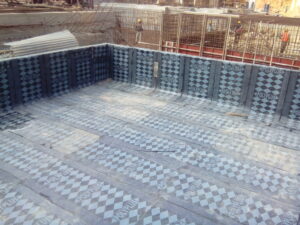

1.Foundation Waterproofing – importance
Foundation waterproofing is an essential process that helps prevent water from penetrating the foundation of a building, which can cause serious damage over time. The foundation is the base of any building and is responsible for holding the entire structure in place. Water infiltration can lead to a host of problems, such as foundation cracks, mold growth, and structural damage. Here are some of the reasons why foundation waterproofing is important:
- Prevents water damage: The primary reason for foundation waterproofing is to prevent water from seeping into the foundation, which can cause damage to the structure of the building. Water can weaken the foundation walls, create cracks, and eventually cause structural failure.
- Prevents mold growth: Water infiltration can also create conditions that are conducive to mold growth. Mold can cause serious health problems and can also compromise the structural integrity of a building.
- Maintains property value: A well-maintained foundation that is protected from water damage can help maintain the value of a property. Unaddressed water damage can lead to costly repairs and can lower the value of a property.
- Provides peace of mind: Foundation waterproofing can provide peace of mind to property owners by ensuring that their building is protected from water damage. This can be especially important for buildings located in areas with high levels of rainfall or where flooding is common.
2. available systems for Foundation Waterproofing
There are different types of foundation waterproofing methods that can be used depending on the specific needs of the building and the surrounding environment. Here are some of the most common types of foundation waterproofing:
- Exterior waterproofing: In case of repairs, the method involves excavating the soil around the foundation and applying a waterproof coating to the exterior of the foundation walls. It may also involve installing drainage tiles and a waterproof membrane to redirect water away from the foundation. For new projects, waterproofing system can be made as a part of structural design involving the waterproofing specialist.
- Interior waterproofing: This method involves applying a waterproof coating or sealant to the interior walls of the foundation. It may also involve installing a drainage system or sump pump to collect and remove water that enters the basement.
- Drainage systems: These systems are designed to manage water that collects around the foundation and direct it away from the building. They may include French drains, which are trenches filled with gravel or rock that redirect water away from the foundation, or exterior drainage systems that use gutters and downspouts to channel water away from the building.
- Waterproofing membranes: These are waterproof membranes that are applied to the foundation walls to prevent water from penetrating the foundation. They may be made from a variety of materials, such as rubberized asphalt, HDPE, EPDM or PVC.
- Damp-proofing: This method involves applying a coating or sealant to the foundation walls to prevent moisture from entering the building. Damp-proofing is not as effective as waterproofing, but it can be a cost-effective option for buildings that are not at high risk of water damage.
The type of foundation waterproofing method used will depend on the specific needs of the building, the surrounding environment, and the budget of the property owner. A professional waterproofing contractor can help determine the best method for a particular building.










3. selection of Foundation Waterproofing system
Selecting the right foundation waterproofing system depends on several factors, including the type of foundation, the location and climate, the severity of water issues, and the budget. Here are some steps to follow when selecting a foundation waterproofing system:
- Evaluate the foundation: In case of repairs, the first step in selecting a foundation waterproofing system is to evaluate the condition of the foundation. This can include checking for cracks, signs of water damage, and the type of foundation (e.g., basement, crawl space, or slab). A professional waterproofing contractor can perform an assessment and recommend the appropriate system for the specific foundation.
- Assess the location and climate: The location and climate of the building can also influence the selection of a foundation waterproofing system. For example, a building located in a flood-prone area may require more extensive waterproofing measures, such as exterior waterproofing or a drainage system. Similarly, a building located in a dry climate may only require a damp-proofing treatment.
- Consider the severity of water issues: The severity of water issues should also be taken into account when selecting a foundation waterproofing system. If water infiltration is a frequent and serious problem, a more robust system, such as exterior waterproofing, may be necessary. However, if water infiltration is minor and infrequent, a less expensive option, such as damp-proofing, may be sufficient.
- Determine the budget: The cost of foundation waterproofing can vary widely depending on the type of system and the extent of the work required. Property owners should consider their budget when selecting a system and work with a professional contractor to find a cost-effective solution that meets their needs.
- Consult with a professional contractor: It’s important to consult with a professional waterproofing contractor who can assess the specific needs of the foundation and recommend the most appropriate system. A reputable contractor will provide a detailed estimate of the work required and explain the benefits and limitations of each system.
GEOLIZ WATERPROOFERS PVT. LTD.
Waterproofing Products & Services Guide
For details on other waterproofing products & Services
